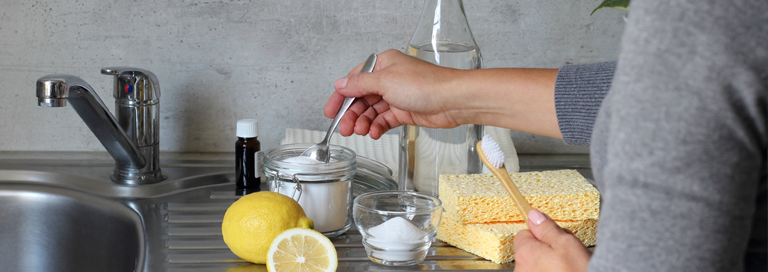It may be hard to believe, but your ultra-clean, insulated home is probably more toxic than any congested city.
According to a recent report by the Environmental Protection Agency, most American homes are between two and five times more toxic than outside.1 So it’s not surprising one in three Americans suffers from allergies, asthma, sinusitis, or bronchitis.
Now several newly published studies have revealed that everyday pollutants you find in your home also dramatically raise your risk of chronic obstructive pulmonary disease (COPD).
Doctors blame tobacco smoke for the COPD epidemic. But that’s just part of the story. The chemicals in your home are also big culprits.
The findings of a 2019 study published in JAMA demonstrated that weekly use of disinfectants for cleaning surfaces increases your risk of COPD by up to a staggering 38%.2
You see, many disinfectants and cleaning products you keep under your sink are “volatile organic compounds,” or VOCs. Tiny droplets from these chemicals can be inhaled through the nose or mouth and lodge deep in your bronchial tubes.
Once that happens, the muscles in your airways tighten, making breathing hard.
Another study found that professional cleaners exposed to household cleaning products had a significantly higher risk of developing COPD.3
Many cleaning products contain lung irritants, such as ammonia, alcohol, hydrogen peroxide, and chlorine bleach. But these aren’t the only dangerous compounds lurking in your home.
Diethyl phthalate is another one. Used in commercial cleaning products, this hormone disruptor has been shown to increase COPD risk.4
But you’re still at risk even if you don’t use heavy-duty cleaners. Diethyl phthalate is also found in toothbrushes, automobile parts, tools, toys, perfumes, shampoo, and food packaging.
In 2017, the Consumer Product Safety Commission banned the use of eight ortho-phthalates in children’s toys and child-care articles.
But when it comes to household items
and personal care products, no legislation by any government agency prohibits their use.It’s up to each manufacturer to decide if they want to eliminate the use of phthalates in their products.
Meanwhile, your kitchen stove, fireplace, laminated flooring, heater, rugs, walls, furniture, clothing, and even the sheets you sleep on, can all be sources of additional indoor air pollutants – like nitrogen dioxide, hydrocarbons, formaldehyde, radon, sulfur dioxide, and asbestos.5,6,7,8
There are also toxins in deodorants, oven cleaners, paints, garden pesticides, laundry aids, floor and furniture polishes, glue, and even, ironically…air fresheners.
That characteristic “lemon-fresh” or pine scent in bleaches and dishwashing liquids comes from “fragrancing” chemicals – limonene and alpha-pinene. The chemicals themselves are not known to be harmful. But once they’re released into the air, they combine to form highly toxic formaldehyde as a byproduct.9
Use the “mother of all antioxidants” to detox yourself
Chemicals that disrupt your hormones also make your glutathione levels plummet.
This is critical because your body needs glutathione, often called “the mother of all antioxidants,” to detoxify itself.
While glutathione is available in asparagus, spinach, and avocados, these sources are broken down before your body has a chance to absorb them.
For many years, trying to supplement with glutathione was useless for the same reason – poor absorption. But the introduction of “liposomal glutathione” was a game-changer.
Wrapping the glutathione in tiny bubbles of fatty acid protects it from rapid breakdown. Just one week of liposomal glutathione increased levels in the blood by up to 40%.
Start with a gram a day of liposomal glutathione…and gradually increase to 1 gram twice daily.
Don’t forget to detox your home
-
- Go green when you clean. Ditch your toxic chemical cleaners for safer ones. There are a lot available nowadays, even at the grocery store. Or you can make your own with baking soda, vinegar, and essential oils.
- Filter indoor air. Home air filters can block particulate matter. Make sure yours rates a 9 or higher on the MERV scale (Minimum Efficiency Reporting Values).
- Use NASA’s humble air filter. A NASA study showed that common houseplants could quickly and efficiently filter out toxic particles from the household air. Here are eight NASA-recommended houseplants that will scrub and purify your home’s air:
• Spider plant (chlorophytum)
• Dragon tree (dracaena)
• Golden pothos (Scindapsus)
• English ivy (Hedera helix)
• Boston fern (Nephrolepis exaltata)
• Bamboo Palm (Chamaedorea seifrizii)
• Rubber plant (Ficus robusta)
• Peace lily (Spathiphyllum)
I recommend two plants for every 100 square feet of your home.
To Your Good Health,

Al Sears, MD, CNS
References:
1. EPA. “The Inside Story: A Guide to Indoor Air Quality.” 2021. Available at” https://www.epa.gov/indoor-air-quality-iaq/inside-story-guide-indoor-air-quality
2. Dumas O, et al. “association of occupational exposure to disinfectants with incidence of chronic obstructive pulmonary disease among us female nurses.” JAMA Netw Open. 2019;2(10):e1913563.
3. Svanes O, et al. “Respiratory health in cleaners in northern europe: is susceptibility established in early life?” Plos One. Jul 13, 2015
4. Shendell DG, et al. “Exposure to phthalates in house dust: Community-based participatory research in a central California county on low-to middle-income older adults with asthma and/or COPD.” Research with Rutgers: SPH-Environmental & Occupat He. 2011.
5. Saki H, et al. “Study of relationship between nitrogen dioxide and chronic obstructive pulmonary disease in Bushehr, Iran, Clinical Epidemiology and Global Health.”2020;8(2):446-449.
6. Connellan SJ. “Lung diseases associated with hydrocarbon exposure.” Respir Med. 2017;126:46-51.
7. Turner MC, et al. “Radon and COPD mortality in the American Cancer Society Cohort.” Eur Rsp J. May 2012:39(5):1113-1119.
8. Wagner U, et al. “Analysis of airway secretions in a model of sulfur dioxide induced chronic obstructive pulmonary disease (COPD).” J Occup Med Toxicol. 2006;12.
9. Horvath EP, et al. “Effects of formaldehyde on the mucous membranes and lungs: a study of an industrial population.” JAMA. 1988;259(5):701–707.

